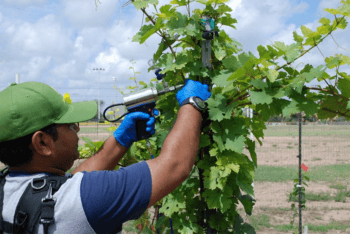Natural Cocktail Used To Prevent & Treat Wine Grape Disease

It’s happy hour at a lab in College Station. The cocktail of choice, developed by scientists with Texas A&M AgriLife Research, is one that stops or prevents the deadly Pierce’s disease on wine grapes.
The discovery could turn a new leaf on the multimillion-dollar U.S. wine industry. Hear, hear.
The study, published in the academic journal PLOS-ONE, describes the use of four bacteriophages that were identified for their ability to attack the bacteria that causes the devastating disease in grapes and several other plants.
A bacteriophage, or phage, is a virus that attacks bacteria. Because they are abundant in the environment, scientists are trying to learn more about the different types and what specific bacteria each can attack. Scientists at AgriLife Research were able to isolate four phages that specifically target Xylella fastidiosa, the culprit in Pierce’s disease.
“The bacteria Xylella fastidiosa is native to the United States and causes disease in many plants including grapevines, oaks, peaches, almonds, coffee and citrus,” said Dr. Carlos Gonzalez, an AgriLife Research plant pathologist in College Station. “We have imported most of our grapevines from Europe, and so therefore the pathogen and the host – in this case the grapevine – did not co-evolve. That made the grapevines susceptible.”
The offending bacteria makes its way to plants via insects. In wine grapes, it’s the glassy-winged sharpshooter. When the insect feeds on a plant, the bacteria is transmitted inside the plant where it travels throughout the xylem vessels, infecting as it goes. The resulting condition, called Pierce’s disease, can cause a vineyard to die in anywhere from a few months to a few years after infection, according to Jim Kamas of Fredericksburg, Texas A&M AgriLife Extension Service horticulturist and outreach coordinator for the Texas Pierce’s Disease Research and Education Program.
Continue reading on AgriLife Today.
This article by Kathleen Phillips originally appeared in Texas A&M AgriLife Today.





